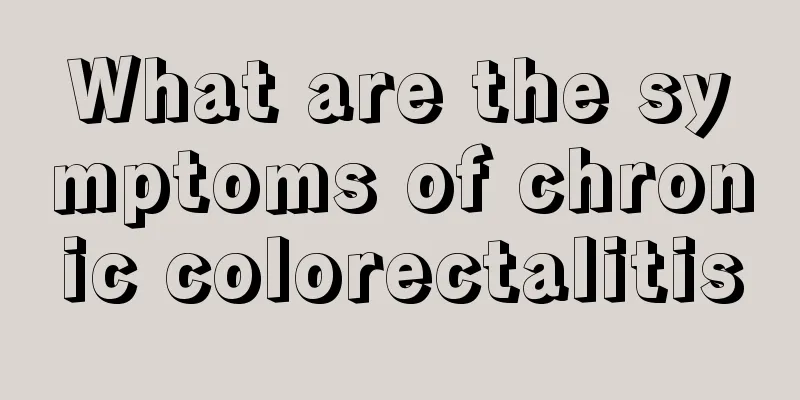What are the symptoms of chronic colorectalitis

|
Chronic colitis and proctitis are relatively common diseases. When patients suffer from this disease, the symptoms are also more obvious, especially abdominal pain and diarrhea, which can easily cause alternating diarrhea and dry stools, intestinal bleeding, and abdominal pain. More serious patients will develop anemia, causing symptoms such as lack of energy and fever. 1. Digestive tract symptoms Common symptoms are abdominal pain, bloating, and abdominal pain. It will be more obvious when exposed to cold or after eating greasy food. The frequency of bowel movements will also increase, and when chronic enteritis occurs acutely, there will also be symptoms of high fever, abdominal cramps, nausea and vomiting. 2. Diarrhea It is the most common symptom of colitis, and is often accompanied by abnormal stools such as mucous bloody stools, watery stools, mucous stools, and loose stools. In mild cases, bowel movements occur every 1 to 2 hours, and the stool is sometimes filled with mucus, pus, and blood, or watery stool without feces. 5% of patients with ulcerative colitis may experience constipation, which is mostly a case of enteritis. Because there is blood in the stool, it is often mistaken for hemorrhoidal bleeding. 3. Constipation Colitis and proctitis are the causes of constipation, which can be caused by systemic metabolic disorders, nervous system diseases, or small anal fissures in the anus. 4. Intestinal bleeding Intestinal bleeding is one of the first symptoms of ulcerative colitis. In most cases, the blood is mixed in the liquid stool or attached to the outside of the stool. 5. Signs of enteritis Long-term abdominal discomfort or dull pain in the lower abdomen. Physical examination may show mild tenderness, hyperactive bowel sounds, and rectal prolapse, mainly in the abdomen, around the umbilicus, or in the lower abdomen. 6. Abdominal pain Patients with chronic recurrent attacks often have abdominal pain, which is mostly mild to moderate spasmodic abdominal pain, mostly in the left lower abdomen and left abdomen. In most cases, it is paroxysmal, short-term, mild abdominal pain. The abdominal pain is significant during diarrhea attacks, and there is a pattern of abdominal pain-urge to defecate-relief after defecation. Severely ill patients may experience persistent severe pain, and severe rectal involvement is often accompanied by symptoms of tenesmus. 7. Blood in the stool Blood in the stool is one of the main symptoms of this disease. In mild cases, the blood is attached to the surface, while in severe cases, fresh blood flows down and even causes shock. 8. Systemic manifestations The face is dull and listless, the limbs are weak, and there is fear of cold. If it is in the acute inflammatory stage, in addition to fever, dehydration, acidosis or shock and bleeding are also the main manifestations. |
<<: The best way to detoxify, these foods can help you do it!
>>: What is the cause of the red papules
Recommend
Can weak spontaneous breathing be restored?
We all know that for some people with respiratory...
What can make eyelashes grow
In life, many girls love beauty very much. Many p...
Benefits of applying tea leaves to eyes
The human eye is a very fragile organ. People use...
Can I eat lychees if I have pharyngitis?
Lychee is a sweet fruit. Eating too many lychees ...
Method of boiling sugar color with water
We often see vendors selling small sugar figures ...
Do I need to get vaccinated if I'm caught by a rabbit?
We all know a common sense, that is, if you are b...
What causes liver metastasis of colon cancer
Many people do not pay attention to their diet an...
What are the symptoms of insomnia due to Yin deficiency and internal heat?
Yin deficiency and internal heat is a common mani...
Treatment and mortality rate of laryngeal cancer
What is the mortality rate of laryngeal cancer? S...
Signs of a person without a strong opinion
For people who have no opinions, there are often ...
The harm of automobile exhaust to human body
There are many hazards caused by automobile exhau...
Common complications of gallbladder cancer
Gallbladder cancer is a common disease in the gal...
What are the causes of metastatic liver cancer? There are four main causes of metastatic liver cancer
Patients with liver cancer should receive timely ...
What to do after gas poisoning
If poisoning occurs while using gas, it is actual...
How to make handmade ice cream
Even in the cold winter, people's enthusiasm ...









